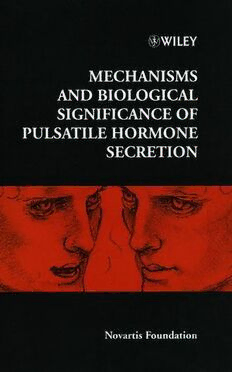
Mechanisms and Biological Significance of Pulsatile Hormone Secretion: Novartis Foundation Symposium 227 PDF
Preview Mechanisms and Biological Significance of Pulsatile Hormone Secretion: Novartis Foundation Symposium 227
MechanismsandBiologicalSignificanceofPulsatileHormoneSecretion:NovartisFoundation Symposium227.Volume227 EditedbyDerekJ.ChadwickandJamieA.Goode CopyrightNovartisFoundation2000.ISBN:0-471-99918-0 MECHANISMS AND BIOLOGICAL SIGNIFICANCE OF PULSATILE HORMONE SECRETION TheNovartisFoundationisaninternationalscienti¢candeducational charity(UKRegisteredCharityNo.313574).KnownuntilSeptember1997 astheCibaFoundation,itwasestablishedin1947bytheCIBAcompany ofBasle,whichmergedwithSandozin1996,toformNovartis.The FoundationoperatesindependentlyinLondonunderEnglishtrust law.Itwasformallyopenedon22June1949. TheFoundationpromotesthestudyandgeneralknowledgeof scienceandinparticularencouragesinternationalco-operationin scienti¢cresearch.Tothisend,itorganizesinternationally acclaimedmeetings(typicallyeightsymposiaandalliedopen meetingsand15^20discussionmeetings)andpublisheseightbooks peryearfeaturingthepresentedpapersanddiscussionsfromthesymposia. TheFoundation’sheadquartersat41PortlandPlace,LondonW1N4BN, providelibraryfacilities,o¡ersaccommodationandmeetingfacilitiesto visitingscientistsandtheirsocieties. InformationonallFoundationactivitiescanbefoundat http://www.novartisfound.org.uk Novartis Foundation Symposium 227 MMEECCHHAANNIISSMMSS AANNDD BBIIOOLLOOGGIICCAALL SSIIGGNNIIFFIICCAANNCCEE OOFF PPUULLSSAATTIILLEE HHOORRMMOONNEE SSEECCRREETTIIOONN 2000 JOHN WILEY & SONS, LTD Chichester · New York · Weinheim · Brisbane · Singapore · Toronto Copyright&NovartisFoundation2000 Publishedin2000byJohnWiley&SonsLtd, Ba⁄nsLane,Chichester, WestSussexPO191UD,England National 01243779777 International(+44)1243779777 e-mail(forordersandcustomerserviceenquiries):[email protected] VisitourHomePageonhttp://www.wiley.co.uk orhttp://www.wiley.com AllRightsReserved.Nopartofthisbookmaybereproduced,storedinaretrieval system,ortransmitted,inanyformorbyanymeans,electronic,mechanical,photocopying, recording,scanningorotherwise,exceptunderthetermsoftheCopyright,Designsand PatentsAct1988orunderthetermsofalicenceissuedbytheCopyrightLicensingAgency, 90TottenhamCourtRoad,London,W1P9HE,UK,withoutthepermissioninwriting ofthepublisher. OtherWileyEditorialO⁄ces JohnWiley&Sons,Inc.,605ThirdAvenue, NewYork,NY10158-0012,USA WILEY-VCHVerlagGmbH,Pappelallee3, D-69469Weinheim,Germany JacarandaWileyLtd,33ParkRoad,Milton, Queensland4064,Australia JohnWiley&Sons(Asia)PteLtd,2ClementiLoop#02-01, JinXingDistripark,Singapore129809 JohnWiley&Sons(Canada)Ltd,22WorcesterRoad, Rexdale,OntarioM9W1L1,Canada NovartisFoundationSymposium227 ix+269pages,70¢gures,11tables LibraryofCongressCataloging-in-PublicationData Mechanismsandbiologicalsigni¢canceofpulsatilehormonerelease/editors,DerekJ. ChadwickandJamieA.Goode. p.cm.^(NovartisFoundationsymposium;227) SymposiumonMechanismsandBiologicalSigni¢canceofPulsatileHormone Secretion,heldattheNovartisFoundation,London,2^4March1999. Includesbibliographicalreferencesandindex. ISBN0-471-99918-0(hc:alk.paper) 1.Hormones^Secretion^Congresses. 2.Biologicalrhythms^Molecular aspects^Congresses. I.Chadwick,Derek. II.Goode,Jamie. III.Symposiumon MechanismsandBiologicalSigni¢canceofPulsatileHormoneSecretion(1999: London,England)IV.Series. QP571.M4252000 99-057033 612.4’05^dc21 BritishLibraryCataloguinginPublicationData AcataloguerecordforthisbookisavailablefromtheBritishLibrary ISBN0471999180 Typesetin101(cid:1) on121(cid:1) ptGaramondbyDobbieTypesettingLimited,Tavistock,Devon. 2 2 PrintedandboundinGreatBritainbyBiddlesLtd,GuildfordandKing’sLynn. Thisbookisprintedonacid-freepaperresponsiblymanufacturedfromsustainableforestry, inwhichatleasttwotreesareplantedforeachoneusedforpaperproduction. Contents SymposiumonMechanismsandbiologicalsigni¢canceofpulsatilehormonesecretion,heldatthe NovartisFoundation,London,2^4March1999 Editors:DerekJ.Chadwick(Organizer)andJamieA.Goode ThissymposiumisbasedonaproposalmadebyFranzSchaeferandJohannesD.Veldhuis JohannesD.Veldhuis Introduction 1 NicholasS.Foulkes,NicolasCermakian,DavidWhitmoreand PaoloSassone-Corsi Rhythmictranscription:themolecularbasisof oscillatorymelatoninsynthesis 5 Discussion 15 AlbertGoldbeter,Genevie'veDupontandJose¤ Halloy Thefrequencyencoding ofpulsatility 19 Discussion 36 PierreDeMeytsandRonaldM.Shymko Timing-dependentmodulationof insulinmitogenicversusmetabolicsignalling 46 Discussion 57 DavidJ.Waxman Growthhormonepulse-activatedSTAT5signalling:aunique regulatorymechanismgoverningsexualdimorphismoflivergeneexpression 61 Discussion 75 StevenM.Pincus Orderlinessofhormonerelease 82 Discussion 96 G.BrabantandK.Prank Predictionandsigni¢canceofthetemporalpatternof hormonesecretionindiseasestates 105 Discussion 114 FrancisLe¤vi Therapeuticimplicationsofcircadianrhythmsincancerpatients 119 Discussion 136 v vi CONTENTS GeorgesCopinschi,KarineSpiegel,RachelLeproultandEveVanCauter Pathophysiologyofhumancircadianrhythms 143 Discussion 157 JohannesD.Veldhuis Natureofalteredpulsatilehormonereleaseand neuroendocrinenetworksignallinginhumanageing:clinicalstudiesofthe somatotropic,gonadotropic,corticotropicandinsulinaxes 163 Discussion 185 PeterButler Pulsatileinsulinsecretion 190 Discussion 199 IainC.A.F.Robinson Controlofgrowthhormone(GH)releasebyGH secretagogues 206 Discussion 220 FranzSchaefer Pulsatileparathyroidhormonesecretioninhealthanddisease 225 Discussion 239 S.L.Lightman,R.J.Windle,M.D.Julian,M.S.Harbuz,N.Shanks,S.A.Wood, Y.M.KershawandC.D.Ingram Signi¢canceofpulsatilityintheHPA axis 244 Discussion 257 JohannesD.Veldhuis Closingremarks 261 Indexofcontributors 263 Subjectindex 265 Participants GeorgBrabant Abt.KlinischeEndokrinologie,MedizinischeHochschule Hannover,Carl-Neubergstr.1,D-30623Hannover,Germany DavidBrown LaboratoryofComputationalNeuroscience,TheBabraham Institute,CambridgeCB24AT,UK PeterButler* DepartmentofMedicine,UniversityofEdinburgh,Western GeneralHospital,EdinburghEH42XU,UK IainJ.Clarke PrinceHenry’sInstituteofMedicalResearch,POBox5152, Clayton,VIC3168,Australia GeorgesCopinschi CentrefortheStudyofBiologicalRhythmsandLaboratory ofExperimentalMedicine,Universite¤ LibredeBruxelles,808RoutedeLennik, B-1070Brussels,Belgium PierreDeMeyts DepartmentofReceptorBiology,HagedornResearch Institute,NielsSteensensVej6,DK-2820Gentofte,Denmark Sta¡anEde¤n DepartmentofPhysiology,UniversityofG˛teborg, Medicinaregatan11,41390Go«teborg,Sweden AlbertGoldbeter Unite¤ deChronobiologieThe¤orique,Faculte¤ desSciences, Universite¤ LibredeBruxelles,CampusPlaine,CP231,B-1050Brussels,Belgium AllanE.Herbison LaboratoryofNeuroendocrinology,TheBabraham Institute,CambridgeCB24AT,UK LiseLundKjems(Bursar) DepartmentofMedicine,TheUniversityof Edinburgh,WesternGeneralHospital,EdinburghEH42XU,UK *Present address: Division of Endocrinology and Diabetes, Department of Medicine, UniversityofSouthernCalifornia,1333SanPabloStreet,BMT-B11,LosAngeles,CA90089- 9113,USA vii viii PARTICIPANTS GarethLeng DepartmentofPhysiology,UniversityMedicalSchool,Teviot Place,EdinburghEH89AG,UK FrancisLe¤vi LaboratoireRythmesBiologiquesetChronothe¤rapeutique, InstitutduCanceretd’Immunoge¤ne¤tique.Ho“pitalPaulBrousse,94800 Villejuif,France JulioLicinio ClinicalNeuroendocrinologyBranch,NationalInstitutesof MentalHealth,Bldg10,Room2D46,10CenterDrive,Bethesda, MD20892-1284,USA Sta¡ordL.Lightman DorothyCrowfootHodgkinLaboratories,Universityof Bristol,DivisonofMedicine,BristolRoyalIn¢rmary,BristolBS28HW,UK JohnC.Marshall DepartmentofInternalMedicine,UniversityofVirginia MedicalCenter,(Box612),Charlottesville,VA22908,USA DavidR.Matthews Chairman,OxfordCentreforDiabetesEndocrinologyand Metabolism,TheRadcli¡eIn¢rmary,WoodstockRoad,OxfordOX26HE,UK AgnetaMode DepartmentofMedicalNutrition,KarolinskaInstitute,Novum, HuddingeS-14186,Sweden StevenM.Pincus 990MooseHillRoad,Guilford,CT06437,USA IainC.A.F.Robinson DivisionofNeurophysiology,NationalInstituteof MedicalResearch,TheRidgeway,MillHill,LondonNW71AA,UK PaoloSassone-Corsi InstitutdeGe¤ne¤tiqueetdeBiologieMole¤culaireet Cellulaire,CNRS-INSERM-ULP,1rueLaurentFries,67404Illkirch- Strasbourg,France FranzSchaefer DivisionofPediatricNephrology,UniversityChildren’s Hospital,ImNeuenheimerFeld150,D-69120Heidelberg,Germany JohannesD.Veldhuis(Chair) DivisionofEndocrinologyandMetabolism, DepartmentofInternalMedicineGeneralClinicalResearchCenter,Centerfor BiomathematicalTechnolgy,UniversityofVirginia,Charlottesville,VA22908, USA PARTICIPANTS ix DavidJ.Waxman DivisionofCellandMolecularBiology,Departmentof Biology,BostonUniversity,Boston,MA02215,USA FrederickC.W.Wu DepartmentofEndocrinology,ManchesterRoyal In¢rmary,OxfordRoad,ManchesterM129WL,UK MechanismsandBiologicalSignificanceofPulsatileHormoneSecretion:NovartisFoundation Symposium227.Volume227 EditedbyDerekJ.ChadwickandJamieA.Goode CopyrightNovartisFoundation2000.ISBN:0-471-99918-0 Introduction JohannesD.Veldhuis DivisionofEndocrinologyandMetabolism,DepartmentofInternalMedicineGeneralClinical Research Center, Center for Biomathematical Technology, University of Virginia, Charlottesville,VA22908,USA One of my favourite de¢nitions from the Oxford English Dictionary is that of wisdom. At this Symposium our assignment is to address the ‘wisdom’ of the neuroendocrine axis(cid:1)that is, to assess ‘aptness in the choice of ends and the pursuit of means’ of these pulsatile signalling systems. I take this challenge to include discussion of the mechanisms by which neuroendocrine signals are generated, communicated, transduced and fed back. Because of the broad range of time-scalesinherent in di¡erentbiological signalling systems, the challengeis particularlycomplex. By way of an overview, a prototypical signalling axis functions as a well integrated homeostatic unit. Exactly how this is accomplished in any given signalling system is not yet well understood. Indeed, whereas one’s research focus is often directed toward understanding a gene, an enzyme, a structural feature of a cell or a collection of cells, the physiological merit of homeostatic signalling is the dynamic ability of the axis to make minute and frequent adjustments,asnecessary,tomaintainthelifeoftheorganismasawhole.Given thehierarchicalcontrolswithinanaxis,itwillbeaformidabletaskintheimmediate futuretoassemblethedetailsofanygivensignallingsystemintoacoherent,well articulated and comprehensive ensemble. Because most available data consist of successive measurements of output from only a single signalling element in the system over time, I believe that success in this lofty aim will require the broad and concerted interdisciplinary contributions of biomedical, computational and mathematicalcolleagues. One proximate goal of this colloquium is to examine critically the more plausible, and experimentally tractable, hypotheses that predict the biological relevanceofpulsatilesignallingmechanisms.Mostofourcurrentnotionsabout signal regulation are not complete, and undoubtedly some are incorrect. Discussionsinthiscolloquiumshouldchallengeill-supportedviewsandpropose others,whenappropriate. Many feedback systems show dominant frequency and/or amplitude control. Indeed,signalvariationisahallmarkofallaxes.However,theexactsigni¢cance oftheindividualandmultiplemechanismsofsignalvariationisnotalwaysclear. 1
